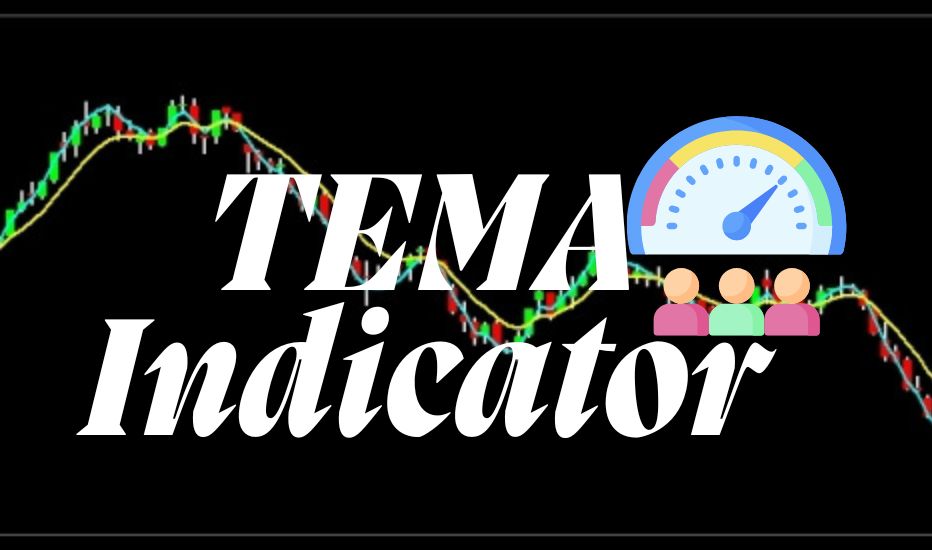TEMA Indicator: A Fast and Responsive Moving Average

The Triple Exponential Moving Average (TEMA) is a trend-following indicator that smoothens price data while minimizing lag. Developed by Patrick Mulloy, TEMA is designed to react quickly to price changes, making it useful for short-term traders and trend-followers.
This article explores how the Triple Exponential Moving Average indicator works, how it differs from other moving averages, and how traders can use it effectively.
1. What is the TEMA Indicator?
The Triple Exponential Moving Average (TEMA) is an advanced version of the Exponential Moving Average (EMA) that reduces lag and provides more accurate trend signals. It’s clear that understanding the TEMA Indicator is vital for minimizing lag in your trading strategy.
Unlike the Simple Moving Average (SMA) and EMA, which can be slow to react to price changes, TEMA applies multiple smoothing calculations to respond more quickly to market movements.
2. How is TEMA Calculated?
TEMA is derived using a combination of single, double, and triple EMAs, making it more sensitive to price fluctuations, a key aspect of the TEMA Indicator.
The formula for TEMA is:
📌 EMA1 = Exponential Moving Average of the closing price.
📌 EMA2 = Exponential Moving Average of EMA1.
📌 EMA3 = Exponential Moving Average of EMA2.
📌 TEMA = (3 × EMA1) – (3 × EMA2) + EMA3
This calculation helps TEMA react faster to price movements while reducing noise.
3. How to Use TEMA in Trading
A. Identifying Trends
✔ TEMA Rising – Uptrend (bullish signal).
✔ TEMA Falling – Downtrend (bearish signal). Identifying these can significantly benefit from the insights provided by the TEMA Indicator.
B. Crossover Strategy
📌 TEMA + SMA/EMA Crossovers
✔ Bullish Signal: When TEMA crosses above a longer-term moving average (e.g., 50-day EMA).
✔ Bearish Signal: When TEMA crosses below a longer-term moving average enhances the effectiveness of the TEMA Indicator strategy.
C. Support & Resistance Levels
TEMA can act as dynamic support/resistance:
✔ Price bouncing off TEMA = Trend continuation.
✔ Price breaking through TEMA = Trend reversal. These actions, noted by TEMA Indicator usage, are key for traders.
4. TEMA vs Other Moving Averages
| Indicator | Lag | Sensitivity | Best Use Case |
|---|---|---|---|
| SMA (Simple Moving Average) | High | Low | Long-term trends |
| EMA (Exponential Moving Average) | Medium | Medium | Trend identification |
| TEMA (Triple Exponential Moving Average) | Low | High | Fast trend trading |
✔ TEMA is best for short-term traders who need quick signals.
✔ SMA/EMA are better for longer-term trend analysis. Comparing these moving averages can enhance your understanding of the TEMA Indicator’s advantages.
5. Best TEMA Settings for Trading
📌 Short-Term Trading: Use TEMA (9, 14, or 21 periods) for quick signals.
📌 Swing Trading: Use TEMA (50-period) to track medium-term trends.
📌 Long-Term Trading: Combine TEMA (100-period) with other indicators for confirmation. By using different settings, the TEMA Indicator can suit various trading strategies.
6. Combining TEMA with Other Indicators
✔ TEMA + RSI – Confirms overbought/oversold conditions.
✔ TEMA + MACD – Identifies trend strength and momentum shifts.
✔ TEMA + Bollinger Bands – Detects breakouts and volatility shifts. Using TEMA Indicator in combination with others can amplify these insights.
7. Final Thoughts
The TEMA indicator is a powerful tool for traders who need fast-moving trend signals with reduced lag. It is most effective when combined with other technical indicators to confirm trend strength and minimize false signals